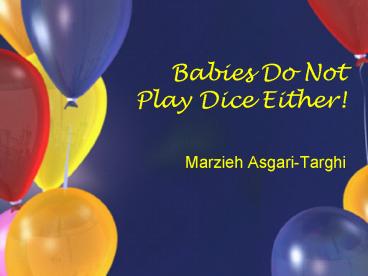Babies Do Not Play Dice Either PowerPoint PPT Presentation
1 / 19
Title: Babies Do Not Play Dice Either
1
Babies Do Not Play Dice Either!
- Marzieh Asgari-Targhi
2
Overview
- I will briefly explain Gopnik et als idea
presented in their 2004 paper. - I shall call into question the key assumptions
underlying Gopnik et als work. - I will then suggest a solution by considering
causality as a non- monolithic notion.
3
Gopnik et als claim
- Infants and children have the prerequisites for
making causal inferences consistent with causal
Bayes net learning algorithms. - Infants and children learn from evidence in the
form of conditional probabilities, interventions
and combinations of the two.
4
Causal Bayes nets
- A Bayesian network is a set of random variables
with a joint distribution, arranged in a network
(graph), and satisfying the Markov Condition. - Causal relations are represented by directed
acyclic graphs. The graphs consists of variables,
representing types of events or states of the
world, and directed edges (arrows) representing
the causal relations between those variables.
5
A Causal Bayes net
6
Causal Markov Condition
- The structure of a causal graph constrains the
probability of the variables in that graph. In
particular, it constrains the Conditional
Independencies among those variables. These
constrains are captured by the Causal Markov
Condition. - Causal Markov Condition For any variable X in a
causal graph, X is independent of all other
variables in the graph (except for its own direct
and indirect effects) conditional on its own
direct causes.
7
Learning from conditional Probability
- Two-and-half-year-olds can discriminate
conditional independence and dependence, that is
conditional probabilities with controls for
frequency, and can use that information to make
judgments about causation. - Experiments (a) one-cause condition
- Children choose A rather than B.
- (b) Two-cause condition
- Children choose equally between A and B.
8
(No Transcript)
9
Children using principle of Bayesian inference.
- In experiments (c) Inference condition and (d)
Backward blocking condition, four-year-old
children used principles of Bayesian inference to
combine prior probability information with
information about the conditional probability of
events. - Four-year-olds can also perform even more complex
kinds of reasoning about conditional
dependencies, and they do so in many domains,
biological and psychological as well as physical.
Monkey and Flowers Experiment.
10
Monkey and the Flowers
11
Learning from Interventions
- The intervention Assumption A variable x is an
intervention on a variable Y in a causal graph if
and only if (1) x is not caused by any other
variables in the graph (2) directly fixes the
value of Y to y and (3) does not affect the
values of any other variables in the graph except
through its influence on Y. - The underlying concept is actually very
intuitive, eg, (2) is basic to understanding
goal-directed action, (3) is essential to
understanding means-ends relations.
12
Intervention is one basic type of evidence for
causation.
- Extensive literature on early imitations show
that nine-month-old infants who see another
person perform a novel intervention ( ie, an
experimenter touching the top of the box with his
head to make the box light up) will adopt that
intervention themselves-the babies will put their
own heads on the box. - I agree with Gopnik that infants and children
learn from intervention but
13
Key assumptions questioned
- How do Gopnik et al arrive from childrens
frequency information to their judgments of
conditional probability? - The children in Gopnik et als experiments gave
answers similar to what would be produced by a
Bayes net, how is it justified to say that they
used the Bayes net approach? Dont children use
some form of Humean regularity theory? - Why causation is identified with probability?
14
Whats Gopnik getting at?
- If the suggestion is that young children have
some kind of causal Bayes net learning mechanism
programmed into their brains, then these
experiments do no prove this. - If the suggestion is that young children can
actually be taught the theory of Bayes nets, then
that is even less plausible, because the very
basic concept in Bayes net is probability, and
there are suggestions that children and young
adults find probability concepts difficult to
learn. See Peter Cheng 2003.
15
Causation is a multi-faceted concept.
- Causes almost always proceed their effects.
Humes Regularity theory of causation. - Causation has uncertainty or probabilistic
aspect. Advocates Suppes, Shafer - Causation has counterfactual facet. Ad Lewis,
Ramachandran, - It has logical facet, causes can be necessary and
sufficient for their effects. Mackie, Bell - Causal Bayesian Networks Glymour, Cooper
- Causality has manipulability aspect. Ad
Collingwood. Menzies, Price
16
Non-monolithic Approch to Causality
- Causality has many different facets. I argue for
a pluralistic model of causality which involves
accepting all the characteristics of causation
and using them in different situation. - Humean regularity theory is our very basic method
for causal inference. The probability models
might be more appropriate in more sophisticated
and developed knowledge situations.
17
- Counterfactual causal models are useful in
situations which we can envisage or indeed build
a possible world in which the existence or
non-existence of causes and their possible
effects can be examined thoroughly. Logical
causal models are used in conceptually difficult
situations, where causes have been identified but
the cause cannot be identified.
18
- Children learn causality from intervention and
they employ Humean regularity theory of
causality. As we grow older and become
sophisticated agents with language skills who can
understand many aspects of causality, we use
various causal tool available to us depending on
contexts we are in. - Pluralistic view of causality suggests a way as
how to strike a good balance between precise
formalism and commonsense reality of causal
contexts.
19
Thank you!

